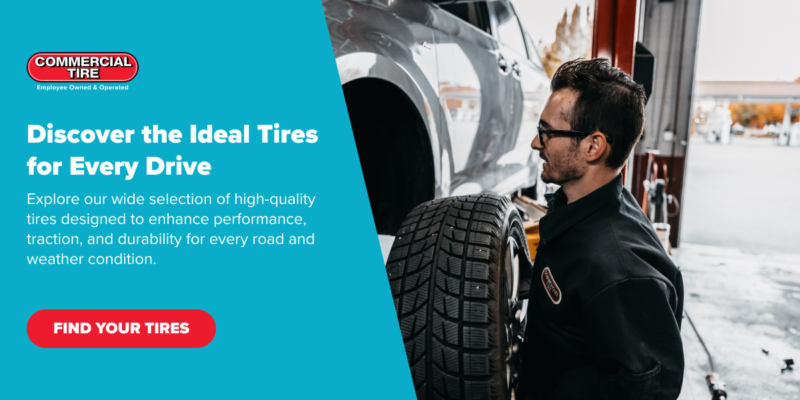Exploring the right times to change your tires can enhance your car’s longevity and performance. Your tires are the only thing between your vehicle and the road—so when they start to wear down, it’s not just about performance. It’s about safety. Knowing how often to replace tires and how to choose tires could mean the difference between stopping smoothly at a red light… or skidding right through it.
At Commercial Tire, we’ve been keeping families, fleet drivers, and everyday commuters safe on the road for over five decades. Tire maintenance is a crucial part of keeping your car in top condition, involving regular tread and pressure checks along with timely rotations and replacements. So let’s dive into when—and why—you should replace your tires and how to make sure you’re getting the most out of every mile.
Why Replacing Your Tires on Time is Crucial for Safety and Performance
We get it—new tires aren’t always top of mind and different types of tires can become overwhelming. But driving on worn-out tires can seriously affect your ability to stop, steer, or grip the road, especially in slick or snowy conditions. When your tire tread depth and wear indicators start to fade, so does your safety cushion.
In fact, one of the most overlooked tire safety checks before road trips is simply measuring your tread. At Commercial Tire, we can ensure your tread is driveable and safe before it becomes too late. It’s a small step that can help prevent hydroplaning in rain, sliding in snow, or blowouts at high speed.
So, if you’re wondering how often to inspect tires, we recommend a quick visual check monthly and a professional inspection at least twice a year, if not more. Waiting until your tire is flat (or worse, fails at 70 mph) isn’t just inconvenient—it’s dangerous.
Factors That Affect How Often You Should Replace Your Tires
Changing tires might be more frequent depending on driving conditions.There’s no one-size-fits-all answer to how often to replace tires. For some, it might be every four years. For others, every six. It depends on a handful of factors—from where you drive to how you drive to your tire wear patterns.
Tread Wear and Depth
This is the #1 reason most folks need new tires. If your tread has worn down below between 2/32 and 4/32 of an inch, it’s nearing replacement time. A simple penny test can help: insert a penny into your tread with Lincoln’s head upside down—if you can see the top of his head, it’s time for a replacement.
Beyond that, many newer tires come with wear indicators built into the tread itself. These bars become visible when your tire is no longer safe to drive. Think of them as your tire’s version of a “check engine” light.
The key to extending your tread life? Following a consistent tire rotation schedule and keeping your pressure in check.
Driving Conditions and Habits
Driving habits that damage tires include hard braking, rapid acceleration, and frequent cornering. Mix in rough terrain, potholes, or heavy loads, and you’ve got a recipe for early wear and tear.
Living in the Northwest, we also deal with constantly changing conditions—gravel roads, icy highways, and everything in between. Choosing the best tires for long-lasting performance means matching your tire type to your environment, whether you need winter/snow tires, highway tires, or something like all-terrain or mud terrain tires.
Keep in mind that seasonal tire care tips—like switching to winter tires when temps drop—can also prolong the life of your all-season tires.
Tire Age and Climate
Even if your tread looks fine, tire age plays a huge role in safety. Rubber naturally breaks down over time, especially in areas with extreme cold, heat, or sun exposure. Most manufacturers recommend replacing tires every six years, regardless of mileage.
If you’re driving on older tires, look for signs of cracking, sidewall separation, or bulges—common signs of a damaged tire due to age. Not sure how old your tires are? Check the DOT code on the sidewall—it’ll tell you the week and year they were manufactured.
Signs It’s Time to Replace Your Tires
You don’t have to be a tire expert to know when something’s off. Here are a few things to look for when deciding between tire repair vs. tire replacement:
Visible Wear (Bald Spots, Cracks)
Worn tread, exposed cords, or visible sidewall cracks mean your tires are overdue. These are all common causes of tire damage that signal a need for immediate replacement. Don’t wait for a blowout—these visual cues are your tires’ way of saying, “Help!”
Decreased Traction and Braking Distance
Have you noticed your car sliding more on wet roads? Taking longer to stop? These are signs your tread can no longer grip the road effectively. Poor traction = poor safety. It also means you’re losing efficiency—and spending more at the pump.
Age of the Tire
Even if your car isn’t driven often, old tires are risky. UV rays, ozone exposure, and temperature swings can break down rubber over time. If it’s been more than six years, it’s a good time to visit your local Commercial Tire shop.
How Commercial Tire Can Help with Tire Maintenance
At Commercial Tire, we don’t just sell tires—we help you protect them. That means everything from proper installation to ongoing service like tire rotation and balance, tire pressure monitoring, how to read your tire size guide, and a flat tire repair guide support.
Not sure if your tire can be fixed or if it needs to be replaced? Our expert techs can walk you through tire patch vs. tire plug options and help you make the safest call.
Need help building better habits? We’ll show you best practices for tire maintenance, teach you how to extend your tire lifespan, and help you stay on top of inspections with reminders that fit your driving routine.
And when it’s time to replace your tires, we’ve got the best brands in stock—Bridgestone, Firestone, Patagonia, Westlake and more—plus options built for all conditions and vehicle types, including high-performance tires, all-weather tires, and everything in between.
Ready to get started? Schedule service or find a location near you and let’s get your tires—and your ride—road-trip ready.
Sources:

